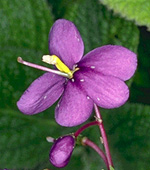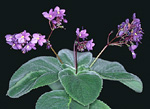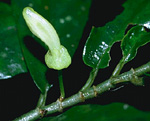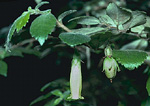 |
The Gesneriaceae are mainly a tropical family, particularly diverse in South America. Relatively few species occur in Australia, and these are restricted to shady, moist places in fern gullies and rain forests from eastern Victoria to north-east Queensland.
Characteristic features of the family Gesneriaceae in Australia include: - usually soft-leaved, perennial herbs (Negria on Lord Howe Island is a shrub or small tree), often epiphytic or growing on wet banks
- leaves opposite, often more or less basally clustered if herbaceous, usually prominently hairy
- flowers showy, attractive, distinctly zygomorphic to almost regular, white, cream, yellow, green, blue, or red, with the petals fused to form a tube at least at the base
- stamens 2, or 4 in equal or unequal pairs
- fruit a capsule or occasionally a fleshy berry, with numerous small seeds
Description
Evergreen trees, or shrubs, or woody or herbaceous scrambling vines, or perennial terrestrial herbs, or epiphytes. Perennating by rhizomes or crowns. Stem internodes solid, spongy or pithy or hollow. Internal secretions not obvious. Plants with simple, glandular or non-glandular, unicellular or uniseriate hairs. Leaves alternate and spiral, or opposite, all or mostly basal if herbs, petiolate. Stipules absent. Lamina simple, symmetric, lanceolate, ovate, oblanceolate or obovate; base cuneate, attenuate or rounded; margins entire or serrate, ±flat; one-veined, or the venation pinnate, with the midrib conspicuous, and the tertiary venation reticulate or not; surfaces not punctate; herbaceous or succulent. All the flowers bisexual. Inflorescences terminal or axillary, consisting of racemes, cymes or solitary flowers. Bracts present. Bracteoles present or apparently absent. Pollination by insects or birds. Flowers odourless; stalked. Floral disc present; nectaries present on the disc. Perianth of 2 dissimilar whorls, valvate in bud. Calyx regular; segments free or fused, with 5 sepals or lobes; calyx funnel-shaped or tubular. Corolla regular or irregular; segments fused, with 5 lobes, alternating with the sepals or calyx lobes; corolla wheel-shaped, urn-shaped or tubular, 1-lipped or curved-tubular, white, cream, yellow, orange, magenta, purple, violet, blue or green, usually streaked, spotted, etc, rarely without contrasting markings, membranous or succulent; claws absent; lobes ±entire. Fertile stamens 2 or 4, opposite to the sepals or calyx lobes, free or at least partly fused to the corolla, free of the ovary and style, distinct from each other, all ±equal or 2 unequal pairs. Staminodes present or absent. Anthers dorsifixed, versatile or not versatile, opening inwards by longitudinal slits, 2-celled. Ovary superior and sessile. Carpels 2, fused; ovary with 1 locule. Style single and unbranched or single and branched above, terminal. Ovules numerous, stalked; placentation parietal. Fruit a dry, dehiscent loculicidal capsule or a fleshy indehiscent berry; the perianth on the maturing fruit deciduous, dry and persistent or growing larger. Disseminule micro-surface ±reticulate, yellow, brown or grey, dull. Seeds numerous per fruit. Aril absent. Cotyledons 2. Embryo straight.
(Note: this description has been generated from the coded data compiled for the key. Any errors in the key data will be reflected in the descriptions.)
A treatment of the family Gesneriaceae has not yet been published in the Flora of Australia. It will appear in Volume 33.
Australian genera of Gesneriaceae (as recognised for the Flora of Australia)
Boea
Cyrtandra
Didymocarpus
Fieldia
Lenbrassia
Negria

|
  |

Boea hygroscopica (flower)
Photo: M.Fagg © ANBG

Boea hygroscopica (flowering plant)
Photo: M.Fagg © ANBG

Cyrtandra baileyi (flower)
Photo: H.Nicholson © H. & N. Nicholson

Fieldia australis (flower and young fruit)
Photo: H.Nicholson © H. & N. Nicholson

|

| |